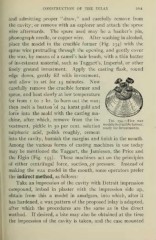Page 233 - My FlipBook
P. 233
:
CONSTRUCTION OF THE INLAY 201
and admitting proper ''draw," and carefully remove from
the cavity; or remove with an explorer and attach the sprue
wire afterwards. The spure used may be a banker's pin,
phonograph needle, or copper wire. After washing in alcohol,
place the model in the crucible former (Fig. 254) with the
sprue wire protruding through the opening, and gently cover
the wax, by means of a camel's hair brush, with a thin batter
of investment material, such as Taggart's, Imperial, or other
finely ground investment. Apply the casting flask, round
edge down, gently fill with investment,
and allow to set for 15 minutes. Now
carefully remove the crucible former and
sprue, and heat slowly at low temperature
for from i to 2 hr. to burn out the wax;
then melt a button of 24 karat gold and
force into the mold with the casting ma-
chine, after which, remove from the in- fig. 254.—Five wax
vestment, pickle in 50 per cent, solution
Teadf fo^r ^vl ^^^^^^^
sulphuric acid, polish roughly, cement
into the cavity, burnish the margins and finish in the mouth.
Among the various forms of casting machines in use today
may be mentioned the Taggart, the Jamieson, the Price and
the Elgin (Fig. 255). These machines act on the principles
of either centrifugal force, suction, ^or pressure. Instead of
making the wax model in the mouth, some operators prefer
the indirect method, as follows
Take an impression of the cavity with Detroit impression
compound, imbed in plaster with the impression side up,
obtain from this a model in amalgam, into which, after it
has hardened, a wax pattern of the proposed inlay is adapted,
after which the procedures are the same as in the direct
method. If desired, a bite may also be obtained at the time
the impression of the cavity is taken, and the case mounted
CONSTRUCTION OF THE INLAY 201
and admitting proper ''draw," and carefully remove from
the cavity; or remove with an explorer and attach the sprue
wire afterwards. The spure used may be a banker's pin,
phonograph needle, or copper wire. After washing in alcohol,
place the model in the crucible former (Fig. 254) with the
sprue wire protruding through the opening, and gently cover
the wax, by means of a camel's hair brush, with a thin batter
of investment material, such as Taggart's, Imperial, or other
finely ground investment. Apply the casting flask, round
edge down, gently fill with investment,
and allow to set for 15 minutes. Now
carefully remove the crucible former and
sprue, and heat slowly at low temperature
for from i to 2 hr. to burn out the wax;
then melt a button of 24 karat gold and
force into the mold with the casting ma-
chine, after which, remove from the in- fig. 254.—Five wax
vestment, pickle in 50 per cent, solution
Teadf fo^r ^vl ^^^^^^^
sulphuric acid, polish roughly, cement
into the cavity, burnish the margins and finish in the mouth.
Among the various forms of casting machines in use today
may be mentioned the Taggart, the Jamieson, the Price and
the Elgin (Fig. 255). These machines act on the principles
of either centrifugal force, suction, ^or pressure. Instead of
making the wax model in the mouth, some operators prefer
the indirect method, as follows
Take an impression of the cavity with Detroit impression
compound, imbed in plaster with the impression side up,
obtain from this a model in amalgam, into which, after it
has hardened, a wax pattern of the proposed inlay is adapted,
after which the procedures are the same as in the direct
method. If desired, a bite may also be obtained at the time
the impression of the cavity is taken, and the case mounted


